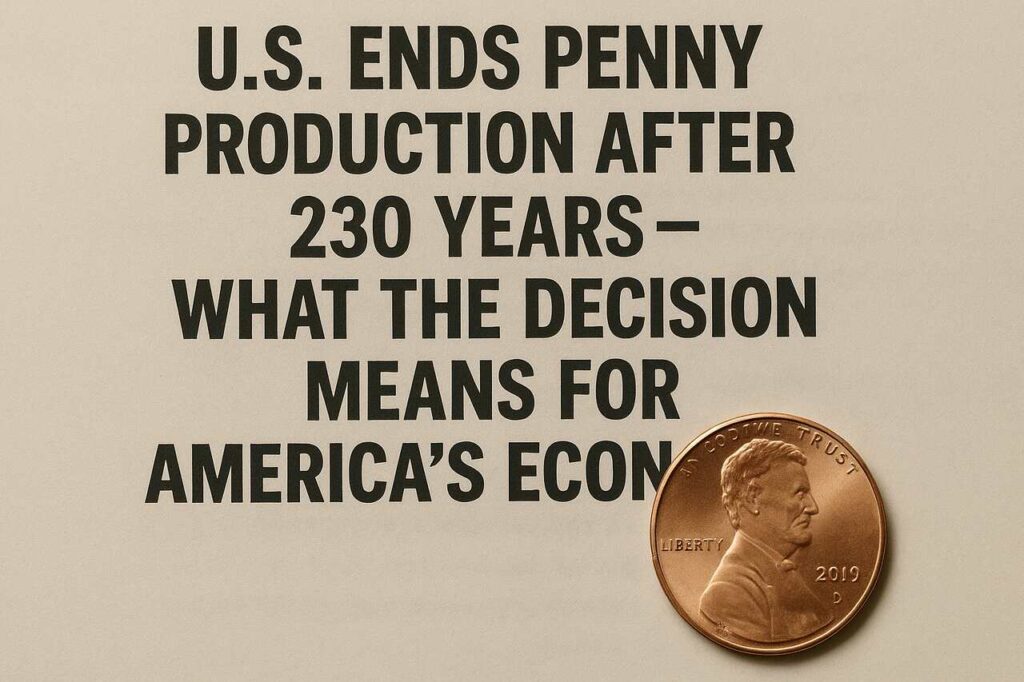After more than two centuries of minting, the United States has officially ended the production of its one-cent coin. The Philadelphia Mint struck the last batch of pennies on November 12, 2025, marking a historic moment in U.S. currency history.
Although existing pennies will remain legal tender, the Treasury Department confirmed that no new one-cent coins will be produced in the future, citing high costs and declining use in everyday transactions.
Why Did the U.S. Stop Making Pennies?
The decision was driven by both economic and practical reasons. According to the Treasury Department, each penny now costs nearly 4 cents to produce — more than its actual face value. Ending production is projected to save the government about $56 million per year.
President Donald Trump, who first announced the move in early 2025, said it was time to “cut the waste from our nation’s budget, even if it’s just a penny at a time.”
The Rising Cost of Copper and Zinc
Modern pennies are composed mainly of copper-plated zinc, and rising metal and manufacturing costs have made production inefficient. A decade ago, each penny cost less than two cents to make; today, that figure has more than doubled.
Digital Payments Reduce the Need for Small Coins
The growth of electronic payments, mobile banking, and digital wallets has sharply reduced the demand for small-denomination coins. Most Americans now prefer cashless transactions, leaving pennies unused or stored at home.
How Many Pennies Are Still in Circulation?
The U.S. Treasury estimates that around 300 billion pennies are currently in circulation — far more than needed for commerce. However, a large portion remains idle. A 2022 analysis found that nearly 60% of all U.S. coins sit unused in homes, piggy banks, or jars, amounting to about $60–$90 per household.
What Does the End of the Penny Mean for Consumers?
With businesses phasing out penny transactions, pricing adjustments are already taking place. Many stores are rounding prices to the nearest five cents to avoid using pennies.
Will Shoppers Pay More?
A Federal Reserve Bank of Richmond study suggests that rounding may cost consumers about $6 million per year. While small individually, this cumulative impact has raised mild concern among budget-conscious shoppers.
Retailers and Businesses Adapt
Some businesses are shifting toward digital payment incentives, encouraging customers to pay electronically rather than in cash — further accelerating the move away from coin use.
Have Other Countries Eliminated Their Lowest-Value Coins?
The U.S. is not alone in retiring its smallest coin.
-
Canada stopped minting its one-cent coin in 2012.
-
Australia and New Zealand eliminated one- and two-cent coins in the 1990s.
-
New Zealand later removed its five-cent coin in 2006.
-
The U.K. paused production of 1p and 2p coins in 2024 after determining enough were already in circulation.
These countries found that phasing out low-value coins caused minimal disruption and produced significant long-term savings.
What’s Next? Could the Nickel Be Retired Too?
Attention is now turning to the nickel, valued at five cents but costing nearly 14 cents to produce. According to the Richmond Fed, discontinuing the nickel could have a much larger economic impact — potentially costing consumers $55 million per year due to rounding effects.
For now, the Treasury has not announced any plans regarding the nickel, but the discussion highlights a broader trend: as digital payments dominate, physical currency is gradually becoming obsolete.
A Symbolic End to an Era
The U.S. penny, first struck in 1793 and famously bearing Abraham Lincoln portrait, has been a constant in American pockets for generations. Its retirement marks the end of a nostalgic chapter in U.S. history — and the beginning of a cashless era where convenience, cost-efficiency, and technology define how Americans spend.

